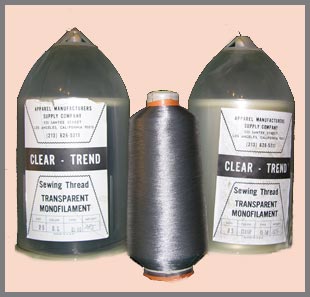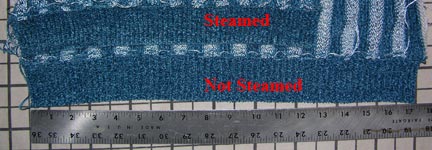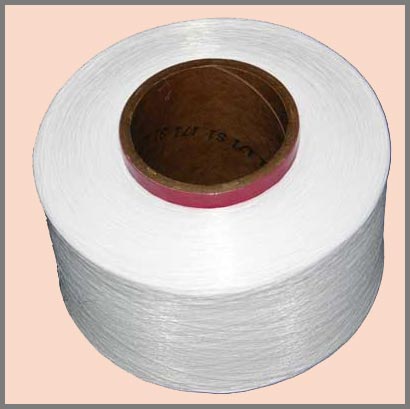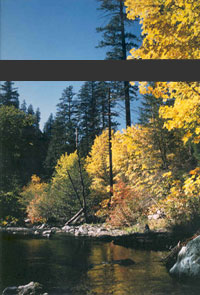Polishing up with Stabilizing Agents
Comparing Lycra®, Monofil, Elastic, and Sewing Thread
"Machine Knit America"
Knitting for Profit Series
Vol.:Four Issue: #two
Release Date: Sept. 1994
Written by Sharon Nani owner of The Knit Tree
The term “stabilize” means to make firm or to keep from changing or fluctuating. There are times when you may wish to do this to your fabric or to parts of it. An example is knitting ribs or trims with rayon or cotton. These two fibers do not have a lot of resilience. Adding a stabilizing agent helps these fibers hold their shape. This is one polishing factor that gives your product a professional look. Your fabric is stabilized by the construction of the fabric or by adding a stabilizing agent such as monofil, lycra®, thread or elastic. I will discuss these stabilizing agents and their pros and cons in this article
NOTE:Click on all images to see an enlargement of the photo!Comparison of Stabilizing Agents throughout History
Monofil ~ Stabilizing Agent popular in the 1980's and Early 1990's

Monofil is a stabilizing agent that came in clear, black, and smoke also used for invisible sewing seams
The first agent is monofil- size 25 type EL-50. Monofil is a strong, fine nylon filament. It looks like fine fishing line. On some knitting machines, it was used for "shadow lace" techniques. Monofil has several good points: it is inexpensive, easy to knit, comes in clear, smoke and dark colors and has a good stretch factor. Stretch Factor is the term used when I am referring to its resilience or how fast, and with how much strength it bounces back to its original shape after stretching. The disadvantages are that it has a harder, scratchy feeling and can become brittle with time and repeated laundering. It was a popular agent used in prior years, but it has since been replaced by the more modern ‘lycra’®.
Monofil is easy to use on the knitting machine. Thread it through the tension system the same as any other yarn. It goes through its own tension disc. The tension disc is set at the tightest tension. If this is not tight enough on your machine, wind the monofil one time around the tension disc before proceeding to the next yarn guide. Join the monofil to the yarn at the eyelet or at the sinker plate. If you have applied too much tension, the needles will be pulled forward. You must also watch that your edge stitches do not get too tight. If they are, apply more weight under this area or gently pull down on these edge stitches as you are knitting over that area. Finally, always remove the monofil before knitting the final row of rib. This holds true for all stabilizing agents. A transfer carriage will not easily transfer a stabilizing agent.
Sewing Thread ~ Wooly Nylon

Off White Wooly Nylon and Grey Sewing Thread are also stabilizing agents used in Knitting
The next agent is sewing thread (size 50-\-40). An example is cotton covered polyester. Threads on cones are more efficient and easier to use. The pros are that you can easily match the color of your yarn, it is strong and easy to knit with, and it is soft to the feel. The cons are that it has only a moderate stretch factor (meaning that it will not stabilize as firmly as the other agents) and it is more expensive. For machine set up and use, see monofil. (author note: today a softer sewing thread agent is available called ‘wooly nylon’.)
UKIsupreme is a manufacturing supplier that has lots of colors of co-ordinating threads with their cotton yarn colors.
Elastic and
Lycra ~ Registered Trademark of Dupont originally - now Trademark is Invista

Sewing Elastic can be used on the knitting machine
Left:
The third stabilizing agent is elastic. It comes on cones in a variety of colors, it is strong and its stretch factor is easily manipulated. I usually use the elastic in the first three rows of the tubular cast on. When elastic is used throughout a fabric, it is stiff and heavy. I always hand feed the elastic so that I can control whether I want the elastic to pull in (apply more tension when feeding the elastic) or to simply lay in the cast on to keep the edge from fanning out during wash and wear. Sometimes the elastic is knit in one row out of every ten rows (or whatever spacing is required for a more shirred effect). Elastic is more expensive, harder to match yarn colors, and adds more weight to the fabric
UKIsupreme is a manufacturing supplier that has lots of colors of co-ordinating elastic with their cotton yarn and thread colors. It comes on cones about the size of serger thread cones.
The image to the left is sewing machine elastic that is readily available at sewing shops. This elastic is thinner then the more industrial elastic made by UKIsupreme, but is also is not as strong and doesn't come in colors.
Right
The last stabilizer is the ‘state of the art’- the newest one on the market- lycra®. This is used on the commercial knitting machines, and we are just beginning to master its use on the home knitting machines. It is soft and has the greatest amount of stretch. Lycra only comes in clear. Some companies make a spandex that has a coating over a percentage of lycra®. It is harder to knit with until you get your tensions on your mast system properly regulated. When I thread lycra®, I bypass the tension disc and go directly to the next yarn guide. This agent needs very little tension. If too much tension is applied, it will break. Sometimes the tension disc is taped open so that the lycra® can go through it as a yarn guide without having any pressure applied to it. Use this procedure if Lycra® is used throughout the fabric, such as in bicycle pants. Most knitters prefer to hand feed the lycra® when it is used in smaller areas.. Thread it in the same eyelet or sinker plate as the yarn and hand feed the lycra® along with the yarn. Set the cone of lycra® on the floor to your left and while pushing the lock (carriage) with your right hand, use the left to guide the Lycra® along with the lock while using your thumb and index finger to apply the slightest tension on the Lycra®. You must watch the Lycra® and ensure that it spins off the cone as you knit. If it sticks under the cone without your notice, it will knit and stretch and pop.

Lycra shrinks after steaming:See the picture to the right of Rayon Chenille Ribbing with Lycra.
Lycra® is used in industry and is now available for home use. It is economical, eliminates color matching, has great stretch and excellent wear ability. It is used for knitting waistbands, cummerbunds and anything that requires a great deal of stretch. One can also achieve interesting effects in fabrication of yarn. Lycra® comes on large cones for easier use. It must always be steamed to get its effect- lycra® is wavy and limp before steam has been applied.
Lycra shrinks after steaming:; See the picture above of Rayon Chenille Ribbing with Lycra. This helps give it the yarn property of resilience or stretch. Notice it is also invisible in this blue rayon chenille..
Tips for Using Lycra on Knitting Machines
*Always use weights when knitting with lycra® *If lycra® does not knit off the needles, you may have to apply more weight and/or increase the stitch size. *If lycra® "grins through" then slightly apply more tension with your fingers. *Lycra works well with all light colors; however, it is easier to see in darker colors. I use it with all colors, you must decide what you like by knitting a swatch first. IN ALL CASES, LYCRA® must be steamed for it to portray the correct properties. Pass steam over the lycra®. Notice that it will "shrivel" into a new shape. Therefore, always swatch and steam to acquire the correct stitch and row gauge.
Machine Knitters can find added tips and projects in Sharon Nani’s supplement booklet “Adventures with Lycra®”, also available in The Knit Tree’s online shopping catalog.
Tips for Using Lycra in Hand Knitting
1. Do not rewind together with the yarn you are knitting it with: Lycra® and yarn have different properties. Therefore, it should be left on its tube, or container unto which you wind it. Hold Lycra® in your hand together with the main knitting yarn, to keep loops from forming as you knit normally. If you want it to have more ‘stretch’ just hold more pressure on the Lycra® as it slides through your fingers in the hand knitting process.
2. After knitting, Pass steam over (do not press steamer – iron on the knit) the knitting with Lycra® in it until it stops shrinking. Steaming activates the properties and gives the Lycra® the resilience.
3. I recommend you knit a swatch to determine the amount of shrinkage. See insert of picture of chenille rayon rib (see photo above with lycra picture) that was in the article I am posting on my web called “Analyzing Garment and Fabric Construction for Different Media.“ I got about 20% shrinkage after steam with the rayon chenille and Lycra®on the knitting machine, not quite as much in my hand knitting. This article goes through the steps of converting machine to hand knitting instructions for a sideways knit sweater of Rayon Chenille and Shiny Chenille by Silk City. The Lace and Stripe Pattern for both hand and machine is in the yarn kits category of my web site.
Lycra Updates
Lycra® is the registered trademark of DuPont / Invista. Sharon Nani is a distributor of lycra® for small lot designers, cottage industries, knit shops, or individuals.. (authors note: Lycra® is available in our Online catalog – you may also find more up to date information in the product description.
Lycra® is Used by Circular Sock Machine Knitters for added Stability to their socks. Lycra® is used by machine knitters, hand knitters, craft people who crochet, fisherman who tie flies, and many more for a variety of uses: to add elasticity to their projects, polishing their cast on’s and trims and to create tri dimensional artistic fabric.
Experiment with lycra, Sewing Thread, Elastic, and Monofil
Each of these agents has an entirely different effect on a yarn. I highly recommend that you do the following exercise each time you try a new yarn and test the stabilizing agents..
Cast on 50 sts in 1:1 rib. Always use weights. Knit 30 rows with yarn and stabilizing agent. Scrap off. Steam each ribbing. Do this with each of the four stabilizing agents. Do not worry if you do not have the proper color. You are testing for effect. Label these swatches for future reference. Record your favorite stabilizer for each yarn. You may like to use each of the four agents for a different purpose, or, you may find that you don’t like the effect of some of them with certain yarns. Stabilizers require experimentation. You must decide for yourself how you feel about them.
Visit us on facebook too ~ page is in development



